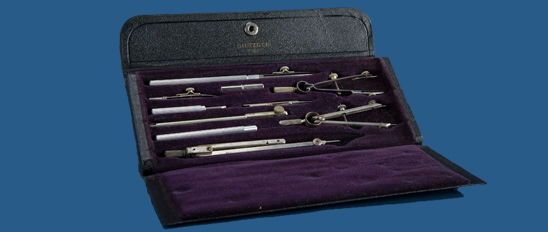This pocket-sized tortoiseshell case has silver trim around the outside, blue velvet lining in the lid, and wooden frame with slots for holding the instruments. The top of the case has a silver plate marked: ANIMO ET FIDE [courage and faith].
- Description
-
This pocket-sized tortoiseshell case has silver trim around the outside, blue velvet lining in the lid, and wooden frame with slots for holding the instruments. The top of the case has a silver plate marked: ANIMO ET FIDE [courage and faith]. Inside the case are: a 4-1/2" pair of silver and steel dividers with one removable point; a silver crayon holder and a pen point that both fit the dividers; a 2-7/8" silver and steel drawing pen; a 4-1/2" ivory rectangular protractor; and a 4-7/8" ivory English-style sector with a silver hinge.
-
The protractor is divided to single degrees and numbered by tens in both directions from 10 to 170. The interior has scales for 1/4", 1/2", 3/4" and 1 inch to the foot. This side is marked: * RUBERGALL COVENTRY. ST. LONDON *. The back of the protractor has scales dividing the inch into 60, 50, 45, 40, 35, and 30 parts; a line of chords; and a plotting scale with diagonal scales at each end.
-
One side of the sector has three double scales: sines, running from 10 to 90 degrees; tangents, running from 45 to 75 degrees; and a second tangent scale, running from 10 to 45 degrees. The outer edge of both legs has scales for logarithmic tangents, sines, and numbers. The hinge is marked: Rubergall (/) London.
-
The other side has a double scale along the fold line for regular polygons, from 12 to 4 sides. Both legs have scales of equal parts, running from 1 to 10 and labeled L; of secants, running from 20 to 75 and labeled S; and of chords, running from 10 to 60 and labeled C. The outer edge has a 9" ruler divided to 1/10" and numbered by ones from 1 to 9. The upper arm has scales labeled In Me [inclined meridian] and Cho [chords] that each run from 10 to 90. The lower arm has scales labeled Lat [latitude], running from 10 to 70; and Hou [hours], running from I to VI. These four scales are associated with making sundials and are characteristic of sectors made in England in the 18th and early 19th centuries. See http://americanhistory.si.edu/collections/object-groups/sectors. Silver inserts protect scale marks where users would frequently set divider points.
-
Thomas Rubergall was an optician and instrument maker whose workshop operated in London from 1802 to 1854 and was located on Coventry Street from 1805 to 1854. The instruments in this case are likely all original to the set. The Smithsonian acquired this object in 1960.
-
References: Science Museum Group, "Collections Online – People," http://collectionsonline.nmsi.ac.uk/detail.php?type=related&kv=104654&t=people; Gloria Clifton, Directory of British Scientific Instrument Makers 1550-1851 (London: National Maritime Museum, 1995), 239.
- Location
-
Currently not on view
- date made
-
1805-1854
- maker
-
Rubergall, Thomas
- ID Number
-
MA.318222
- accession number
-
233319
- catalog number
-
318222
